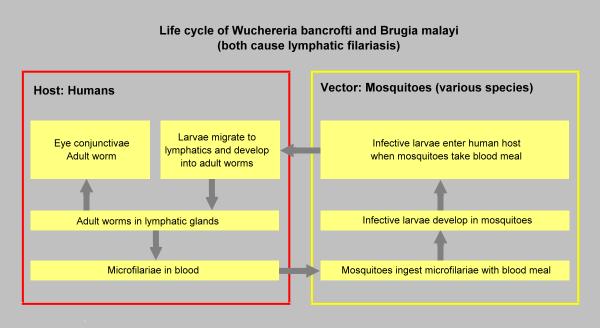Envis Centre, Ministry of Environment & Forest, Govt. of India
Printed Date: Wednesday, September 10, 2025
More About Filarasis
Lymphatic filariasis (LF) is a disabling, disfiguring infection caused by nematode parasitic worms. It is a major cause of disability and is considered as social stigma, and is a burden psychologically and economically on account of the costs for surgical intervention. The disease is a major contributor to poverty. It is estimated that 120 million people are infected in around 80 countries through tropics and sub tropics. (WHO 2000.15).
Parasites
Lymphatic filariasis is a disease caused by a group of nematode worms belonging to the order "Filariidea" and transmitted to man
by the infective bites of blood-sucking arthropods. In man , it is caused by three parasites namely Wuchereria bancrofti,
Brugia malayi and Brugia timori. Ninety percent of these infections are caused by Wuchereria bancrofti and remaining by Brugia malayi and B.tiromi. (VCRC, 1998). Figure: 1
Vectors
Filarial causative parasites are transmitted by female mosquitoes of Culex, Anopheles, Aedes and Mansonia species.
Culex quinquefasciatus is a ubiquitous species and is abundant in tropical and sub tropical countries. It is the principal vector of Bancroftian Filariasis in India.
Distribution
Brancroftian Filariasis in India is mostly found in Andhra Pradesh, Orissa, Asssam, Madya Pradesh and TamilNadu and Brugian Filariasis in India is mostly found in Kerala, but scattered foci of low prevalence are reported in above states. A focus of subperiodic Bancroftian Filariasis has been described in the Nicobar Islands. (WHO, 1992)
Life cycle of lymphatic filariasis

.JPG)
Geographical distribution of lymphatic filariais.
Burden
The World Health Organization (WHO) estimated that 72.8 million persons are infected with W. bancrofti, and 5.8 millions with B. malayi and B. timori, among a total of 751 millions exposed .(WHO, 1992).
In South-East Asian Region, it is estimated that about 600 million people are living in the endemic areas, constituting about 60% of the global burden with about 60 million persons either harboring microfilariaemia or suffering from clinical manifestations.
In India, Filariasis is a major public Health problem next to malaria where 18 states and Union Territories are LF-endemic. India's National Filaria Control Programme (NFCP) was launched in 1955 and evaluated in 1960, 1971, 1982 and 1995. According to present estimates, about 454 million people are at risk, 113 million of them in urban areas where NFCP activities were focused. (WHO 2000.5).
In Andhra Pradesh, NICD/NMEP reported 53.47 million populations are at risk, of these 3.97 million persons with microfilariaemia and 1.48 million with disease (NICD/NMEP, 1996).
In East Godavari District, according to the NICD/NMEP reports, 4.91 million population is at risk based on the survey conducted in 1983. Out of this, 16.70 million people are reported to harbour mF and 8.90 million with disease (NICD/NMEP, 1996).
Economic Burden
Lymphatic Filariaisis has been identified as one of the potentially eradicable disease and 50th World Health Assembly, 1997 has passed a resolution declaring elimination of filariasis as a Public Health problem. (VCRC, 1998)
In India, estimated 454 million people living in 257 districts in 18 states are at risk of infection. A nationwide programme requires distribution of DEC at the dose of 6 mg / kg per person requiring 5000 of 50 mg strength per 1000 population. For the entire endemic population, about 1.1 billion 100 mg or 2.2 billion 50 mg tablets are required .The per- capita cost of annual DEC mass treatment programme has been estimated at Rs. 1.32 (US $ 0.028). This cost, however, may go up to Rs. 2.00 (US $ 0.043) because it is widely felt by programme managers and researchers that campaign with more financial inputs is required to sustain the programme. (Krishnamoorty, K et al; 2000). At the per capita cost of Rs. 2.00 (US $ 0.043), a country wide programme may cost around Rs. 900 million (US $ 19 million). Economic loss in India has been estimated at U.S $1.5 billion (Rs. 720 Crores) every year ( VCRC unpublished data, Ottesen et al ;1997).
Keeping the importance of Database in the planning strategies of vector control in the view, we have taken up a study to create an informative database on filariasis in the above districts of A.P.
Click here for Bibliography on Filariasis